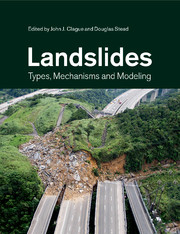9 results
Index
-
- Book:
- Landslides
- Published online:
- 05 May 2013
- Print publication:
- 23 August 2012, pp 409-420
-
- Chapter
- Export citation

Landslides
- Types, Mechanisms and Modeling
-
- Published online:
- 05 May 2013
- Print publication:
- 23 August 2012
Contributors
-
-
- Book:
- Landslides
- Published online:
- 05 May 2013
- Print publication:
- 23 August 2012, pp vii-x
-
- Chapter
- Export citation
Landslides - Half title page
-
- Book:
- Landslides
- Published online:
- 05 May 2013
- Print publication:
- 23 August 2012, pp i-ii
-
- Chapter
- Export citation
Contents
-
- Book:
- Landslides
- Published online:
- 05 May 2013
- Print publication:
- 23 August 2012, pp v-vi
-
- Chapter
- Export citation
13 - Numerical modeling of rock-slope instability
-
-
- Book:
- Landslides
- Published online:
- 05 May 2013
- Print publication:
- 23 August 2012, pp 144-158
-
- Chapter
- Export citation
Copyright page
-
- Book:
- Landslides
- Published online:
- 05 May 2013
- Print publication:
- 23 August 2012, pp iv-iv
-
- Chapter
- Export citation
Preface
-
-
- Book:
- Landslides
- Published online:
- 05 May 2013
- Print publication:
- 23 August 2012, pp xi-xiv
-
- Chapter
- Export citation
Landslides - Title page
-
-
- Book:
- Landslides
- Published online:
- 05 May 2013
- Print publication:
- 23 August 2012, pp iii-iii
-
- Chapter
- Export citation



